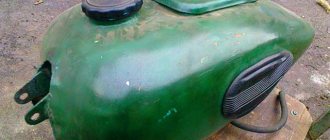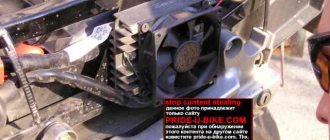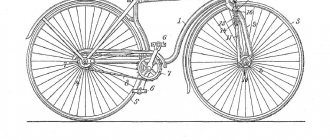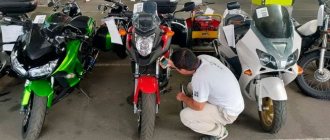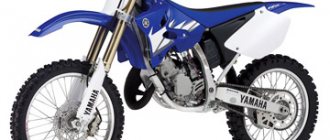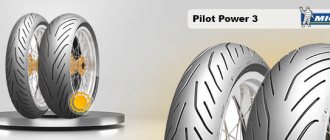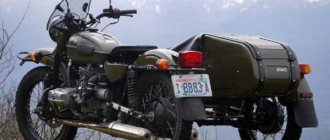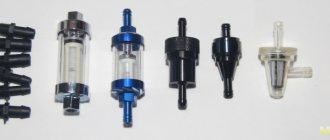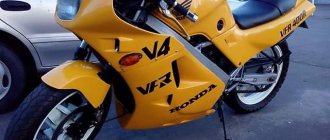HOW I MAKE MOTORCYCLES
A year or two passes - and the tool boxes begin to rattle, cracks creep along the rear fender, the number plate along with the bracket falls off... And if the motorcyclist, God forbid, gets into even a minor accident or even simply falls? In these cases, the frame bends and dents appear on the tank and tool boxes. Huge lower mufflers cause even more trouble, clinging even to smooth asphalt when cornering and significantly reducing passability on bad roads.
The two-wheeled vehicle, designed according to the “monocoque” design scheme, is free of all these shortcomings. Such a motorcycle is a monoblock welded box-shaped structure that performs the functions of all the parts and assemblies listed above. Interestingly, the spatial box structure is significantly more rigid and durable than the classic frame structure (including duplex frames). The use of a monocoque design in a motorcycle design not only reduces the weight of a two-wheeled vehicle, but also brings the center of gravity of the motorcycle closer to the ground. This happens due to the fact that in this design the tool box and battery compartment are located in the lower part of the body, and a lightweight air filter with an intake noise muffler is located in the upper part, where the fuel tank cap is located on classic motorcycles. The air intake is made above the steering column - in this area the cleanest, dust-free air is. An exhaust noise muffler may also be located inside the monocoque, but reliable thermal insulation from the fuel and seat cushion must be ensured.
Rice. 1. Enduro-type motorcycle with a monocoque body designed by L. Garagashyan:
1 — rearview mirror, 2 — secret fuel tank plug, 3 — shock absorber compensation chamber, 4 — shock absorber with a stroke of 120 mm, 5 — swing arm, 6 — push lever, 7 — brake rod, 8 — rear part of the body with exhaust muffler (left) and oil tank (right), 9 — rear turn signal, 10 — parking light and brake light (dual), 11 — exhaust pipe (left), 12 — brake disc with a diameter of 300 mm, 13 — chain catcher, 14 — rear wheel sprocket (z=37), 15 — rear wheel suspension pendulum, 16 — drive sprocket (z=15), 17 — foot brake pedal, 18 — drive box lever gears, 19 - winch drum, 20 - muffler - resonator, 21 - winch cable guide bracket, 22 - front brake disc with a diameter of 300 mm.
Rice. 2. Monocoque body layout. The cell size of the scale grid is 100×100 mm.
Rice. 3. Diagram of the most rational welds used in assembling a monocoque body.
Pictures 1 and 2 show my enduro motorcycle and its monocoque body with rear suspension and engine protective frame. The weight of the monocoque is only 23 kilograms, and the useful volume of such a body is about 56 liters, of which 41 liters are for fuel tanks (more than that of the Zhiguli!), and the remaining volume of the body is fully used. At the same time, the motorcycle does not look bulky. On the contrary, it has relatively small dimensions - in particular, the base of the car is only 1350 mm (smaller than any Izhevsk motorcycle).
It must be said that making a monocoque body is no more difficult than welding a good frame and equipping it with all the attached parts. You just need to strictly adhere to the pre-developed technology so that all the parts fit together well and are convenient to weld.
When drawing the design of the body, take care to ensure a comfortable position for the driver - this is especially important for enduro-type motorcycles - as well as the safety of the motorcyclist’s movements, ease of movement in a sitting position, in a rack and in the drawbar.
After choosing the optimal, in the designer’s opinion, layout solution, you should draw the entire motorcycle in full size - depict a side view, top view, front and rear, and also draw the most characteristic sections. The more detailed the drawing documentation, the easier further work on the manufacture of a two-wheeled vehicle will be.
It is most rational to place the engine directly on the axis of the pendulum. In this case, the reaction from the tension of the drive chain is connected directly to the pendulum. And it is far from small - sometimes it reaches the breaking strength of the chain, that is, almost two tons! It is necessary to mount the powerful and not very well balanced Izh-Planet engine (as well as all cross-country motors) using silent blocks or rubber cushions. You just need to take into account that the chain not only pulls the engine back, but also turns it in a horizontal plane due to the asymmetrical arrangement of the chain.
When creating a monocoque body, it is very convenient to use the volumetric prototyping method. In this case, the model of the body is assembled from cardboard blanks, which are connected using strips of paper and glue. In the process of making a model, as a rule, changes occur in the design of the body, since not everything can be provided for in flat drawing projections. Simultaneously with prototyping the body, it is advisable to work out a technological map of its assembly - this will ensure the convenience of welding work. It is necessary to take into account the possible warping of metal workpieces when welding the body with uneven heating. Keep in mind that the parts that hold the swingarm and steering column are welded last. If necessary, they should be adjusted to the body so that on the finished motorcycle the planes of the wheels coincide with the plane of symmetry of the monocoque body.
The finished volumetric model is cut at the gluing points, and the cardboard patterns of the monocoque elements are numbered: it is from these patterns that blanks will be cut from a steel sheet of the appropriate thickness - from 1.2 to 1.5 mm. The easiest way to do this is with a chisel on a massive anvil.
Welding should be carried out in strict accordance with the technological map. To make the seams look neat and strong, the edges of the parts being welded should be slightly bent, as shown in Figure 3.
To ensure sufficient strength of the monocoque body, it is advisable to introduce additional reinforcements, flanges, and stiffeners into its design. For example, the steering column on my motorcycle and the transverse stiffening beam, to which the bracket for the only shock absorber of the rear suspension is welded, are additionally connected by a rectangular steel pipe of 25x40 mm. In addition, it is convenient to place electrical wiring and motorcycle control cables inside this pipe.
The design of the intake silencer significantly affects the engine power and its torque characteristics. The larger its volume, the easier the engine “breathes,” and the less air pulsation in the filter, which means less noise. Experts recommend setting the muffler volume to at least 20 engine displacements. The path from the air filter to the carburetor must be smooth, eliminating turbulence in the air flow, which significantly reduces engine power.
After welding, the monocoque body is checked for leaks - first with water and then with clean gasoline. If there are no leaks, the welds are coated from the inside with liquid epoxy glue - it will fill small pores, bind pieces of slag and drops of metal - this is especially important for the intake noise muffler.
The rear suspension is pendulum type, with cantilever wheel mounting. Wheel travel is about 260 mm. The pendulum hinge is on ball bearings and sealed with oil seals. Chain tension is done using an eccentric. The disc brake is mechanically driven.
The front suspension is based on the fork from the CZ-516 cross-country motorcycle. The wheel is for 21-inch tires, the disc brake pad drive is hydraulic.
The soft saddle pad is glued directly to the monocoque body, and the faux leather cover is attached to it with flush screws.
I would like to warn readers who do not have sufficient experience in designing motor vehicles that creating homemade two-wheeled vehicles is a very difficult matter. In this material I tried to talk about my work and those ideas that I consider promising for amateur motorcycle building. However, I would categorically not advise novice motorcycle builders to start creating a powerful machine based on this material. It might be better to start with simpler motorcycles. After all, I was moving towards a monocoque, having created more than a dozen intermediate structures...
Alexey GARAGASHIAN, St. Petersburg
We recommend reading
- PUSHING... PHOTOGRAPHS To obtain a good gloss on a photograph, you need to roll it tightly onto the electro-gloss plate. It’s very convenient to do this using... a washing machine, or rather, a wringer...
- Two combat “wings” Developed in the aircraft modeling circle of the station of young technicians in the city of Berezniki, Perm region, and the “air combat” models offered below are intended for intermediate-level athletes. Their…
Here you can evaluate the author's work:
Wermachtocheck - How to craft a frame.
The idea to make a frame came to me a long time ago. About two or three years ago. Then it seemed like an hardly feasible task, due to the lack of everything for this task except an afterthought desire) It was necessary to somehow figure out how to do it in general, where to get the pieces of iron, how to secure it for welding and at the same time maintain the dimensions, and generally where to get it a welder and learn how to use it for the glory of Svrog. Now I have overcome these difficulties and created what was destined. And actually, why not? Look at the frame like this. Here is one pipe, here is the second, here we welded it, here is the bearing, everything seems to be clear. Let me try to do the same)) At first I thought about making a hardtail (sort of simpler), but then I decided that I already had one, and I needed a light trail mini-hash suspension for Yerinets, so I decided to make something similar to it. Not very light, of course, but still) Design research began with an analysis of existing structures in order to determine the required geometry and suspension parameters. Having reviewed a bunch of frames, I took the following geometry: Base 1160 Stays 430 Reach 405 Head angle 65 g Seat angle 71 g Effective length of the top tube 616 mm Shock 200*50 Travel 140 mm Weight about 5 kg Subsequently I found out that the glass was painfully filled up, as I would have liked a little sharper controllability. You need 66g. And the feathers are shorter. And the hinge is higher, otherwise the pedalkick is rather weak, which is why the suspension still wobbles when falling in. So go ahead) I decided to make the suspension in the form of a single lever. Actually, why more?) Motolink is done if you want more progression in work, but I wanted it to be more linear, locking the brake is garbage by and large, especially on a short stroke, and with the build-up everything is easily solved. And it’s the easiest thing to do, because you don’t have to bother with a bunch of hinges and links, and they all need to be coordinated during welding.
Well, I figured it all out, developed the suspension, and it turned out like this:
Then I began to detail the nodes and think more precisely about the connections and the shape of my product in the transverse plane.
Now the question arose, where can I get these pieces of iron?) At first I wanted to get everything from a metal warehouse, where there is a very wide range of pipe sizes, and not only them. I was a little confused by the fact that on their website, in the “remaining” column next to each pipe, something like “>5 wagons” or “<3 tons” was listed. It turned out that the minimum length of the pipes they sell is 12 meters. Not a carriage, of course, but still a bit much. I still need less. Well, I went to the nearest construction market, the assortment there, of course, was poorer, the pipes I took were not the ones I originally thought I would take, but joyful, with the pipes tied to my bike, I left there. For reference, the front triangle pipes are 32*1.5 2.5 meters, for the rear triangle the square is 15*15mm 3 meters. There was also one problem initially - where to get the pipes for the steering tube, carriage and hinge. The fact is that standard pipe sizes are not at all suitable in terms of diameter and surface cleanliness. Yes, and the threads in the carriage still need to be cut, but the taps stand like a frame. I figured out the carriage quite easily. I sawed it off from an unnecessary frame from a children's shawl. What about the glass and hinge? And it’s also simple)) The world is not without a cunning hamster) We saw a pipe larger than the required diameter lengthwise, give it the required diameter with a hammer and a vice and weld it)) Alle-up! The weld on the steering tube is an emblem)) I decided to take more bearings, with a reserve. I took 25*47*12. I realized that I went too far)) Next time I’ll take less... The workbench acted as a workbench, to which I successfully screwed and welded a bunch of pipes.
Only when the transfer was undershot did the flimsy front shock absorber mount bend. It was straightened and strengthened.
Recently I jumped on a one-meter flat jumper and nothing else broke. The bike generally rides great, takes turns like butter, is very versatile - I lifted the seat and went to bike orienteering.
I lowered it and our beloved nanodh went. I really like it. And you don’t mind scratching)) It looks cool in a rusty color!
Oh no, not like that))
Like this!))
The prototype named his creation Sledgehammer Fox.
Strength test video) https://vk.com/video20558508_166519608 I don’t understand how to insert a video so that it plays directly in the post. And now about my second frame) As mentioned, it is downhill, made of sheet metal and more beautiful. Geometry: Base 1190 Adjustable stays 430-450 Head 64° Seat 73.5° Reach 400 Travel 225mm Shock 240*76
Weighs 5200g As I already said, it is made of a beautiful sheet of iron, which I bought at my favorite Lublin market. Once again, some problem arose with the volume of delivery - this time the smallest sheet that they could sell me had dimensions of 2.5 * 1.25 meters, which is pretty crazy. He rushed me from the market to the workshop, too, quite epically. For successful transportation, it was folded in three, tied with wire to the first Sledgehammer and carried on foot for 3 km like this. It's good that I didn't worry about painting my first creation.
Historically, it so happened that you first had to draw what you want to do. (Nothing is visible because the drawing is secret. What did you want?)
Well zbs now). Calculate the suspension there, the pipes from which to craft, yes, well, you get the idea)
I depicted the suspension with one lever, and made the hinge higher so that it would not swing. The suspension really doesn’t sway at all and accelerates like a hardtail. The pedalkick, however, is a bit large - when you turn on the sausage, you can feel the shocks on the pedals. For my 38 star, the hinge needs to be lower. Well, or a bigger star) Although, on the other hand, it’s very convenient. You can lick the bumps just like on a Hardale while spinning the pedals.
I made the leverage curve more progressive than on the first trail Sledgehammer. The most progressive, which can be achieved with only one lever, as far as my brain was enough. I must say, it works well. It's eating. I dropped about a meter and a half onto the plane - it didn’t even seem to break through. In general, leverage depends on taste and color. Some like it more linear, some like it more progressive. There are many four-link frames available with more linear leverage than mine. There are even regressive ones. I think this is a hint that I'm right. Otherwise, some people simply say that the more progressive, the better. I think it's not that much. The same as with the rigidity of the frame (or fork) in the transverse direction (like “the inverted torsion bar is bad”). I drew the development of pipes on a sheet of paper and cut them out using mitol scissors. This is such a hectic activity, it turns out. The sheet curls into a tube, is difficult to cut, pricks with burrs, but still cuts several millimeters at a time. Next time we will do it on a laser cutting machine.
In short, I cut it out, bent it with a vice and a hammer, welded it - this is what happened. (The photo shows all three pipe options. Now we are talking about the pipe closest to the observer)
It’s as if he didn’t brew it with his hands, but pooped it with his butt. I can explain why, by the way, otherwise you’ll think that I’m always such a bad cook. If you are not interested, read the next paragraph) In short, you need thinner electrodes and less afterburner, which was not adjustable on my welder. I bought another one. That's it, end of explanation, screw it) I fixed it. Made the second iteration of my welded pipes. (middle in the photo) I tried my best. I must say without unnecessary modesty that it is quite good, although unstable. Considering that this is a sheet 1 mm thick, and I welded it with ordinary electrodes using a transformer welder, which they gave me for free, because they thought it had burned out) And I was a less experienced welder then than now. In general, the big problem when creating the previous frame was the lack of a normal slipway, and screwing it to the table was not cool and the girls would laugh. I started googling how to make a manned slipway and what they should be like. I accidentally came across the company Triton bikes, which makes titanium frames for front straps, and is also located in my area. I was incredibly happy and surprised by this. He came like that to them. “Excuse me, I say, I want to make hanging ramanama, so here it is...” They answer: “Do namana, there will be namana, yo.” They helped with argon, a place under a bench, sheltered a native craftsman, that means.
I looked at them to see how to make frames straight and realized that I needed to redo all these carriages and glasses of mine, sawn off from Auchans and lengthened with pieces of pipes due to the fact that there were no Auchans with 83mm carriages and smooth (as it seemed to me) monocoques welded with electrodes .
Let's return to our stocks for a moment. As you know, it is inconvenient to hold the left upper feather with your teeth and try to weld it, so to make the rear triangle you need to make a slipway. Like this one, big and iron. From a corner lying under the bed, 65*65mm, as far as I remember.
Well, the front triangle was assembled on a hardtail slipway.
It turned out like this.
Then they painted it some more. In yellowish)
Dough.
Since the frame is downhill, testing it in Moscow is clearly not enough. No, of course, after assembling, I first popped the flats and ladders a little, so that if it turned out to be absolutely crap, it would come to light earlier. Then we went to Nizhny Novgorod to the Oksky Dh highway. The first thing that is very noticeable is that the bike accelerates very easily, despite its weight of just over 20 kg. The high hinge works. Toko, as I already mentioned at the beginning, I raised it too high for 38 stars. Next time it will be lower. However, at a race I took the crazy junior Vlad Cherruble to ride at his Downhill Polygon. So this frame broke my entire understanding of modern Dx frames. She just has a giant pedalkick! This is despite the fact that they usually do it either just a little bit (Kona, Bergamot, Commensal, Scott, Lapierre, Mink), or so that there is no pedal at all, but then the suspension swings more (Intense, Dema, Transition). Accordingly, when overclocked, the bike becomes even more of a Shooter than my Sledgehammer. And when you don’t turn the pedals, everything works fine and there are no pedal kicks. In my opinion, this is very convenient, because the suspension hardens exactly when you screw it in, which is exactly what we need, unlike the platform, which is always there. In general, you need to go to the mountains to assess whether this resistance to swinging will interfere much when screwing on rocks or whether it will still be normal. Vlad, of course, doesn’t care, but what if a rider with a lot of self-preservation instinct comes across)
In general, the Triton Sledgehammer rides like an ordinary good modern downhill frame; there is nothing unusual in the geometry, and it, too, is a very subjective substance, as you know. For example, I like 430 mm chainstays. With 450 vel it becomes a long and mega-stable train with a base of 1210 mm for M size. I like it that way too, I’ll have to test it more extensively in the mountains. At non-mega speeds, 430 is more convenient, in my opinion. And just now the frame went through a baptism of fire with a race! The first competition for her was the Ivanteevka Hill Race, which took place on December 8 in, oddly enough, Ivanteevka. As you can see from the photos, the fork at the time of the race was my favorite Shiverochek. The boxer went to the bulkhead. Arithmetically we deduce that the assembled wheel now weighs a whopping 21 kg! I, of course, suspect that this is a bit much for flat Ivanteevka. However, by applying insane efforts, I manage to take 2nd place in the Men category (Elite according to the old style) and in the absolute category too. There I gave Ivan Kunaev a ride on his bike (who, damn it, overtook me, no matter how hard I tried)). He said it was going well, but it was a bit heavy, something)
That's it.
The girl in the photo: fashion model-welder Olya Manulka. By the way, this frame has seams made by its paws) He is also interested in cutting out pieces of the frame from a sheet, figure sawing with a grinder and cute clapping eyes)
Thanks to Triton bikes, in particular to Dima Gazza Nechaev, Sanya, Sergei Lvovich, Nikolai Ivanovich for their help and guidance and faith in a bright future with titanium suspensions!)
HOY!)
